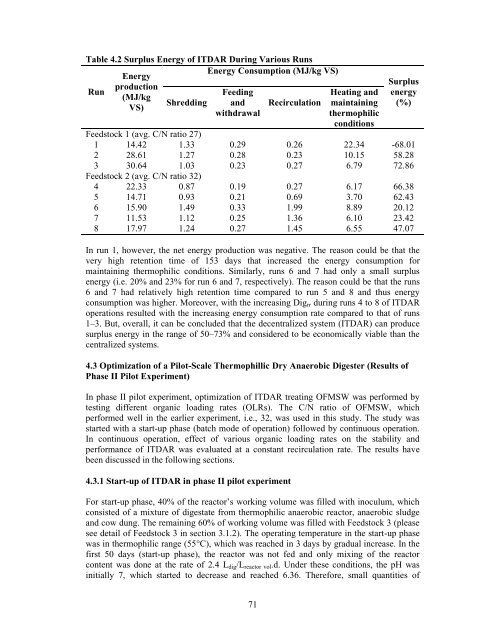dry anaerobic digestion of municipal solid waste and digestate ...
dry anaerobic digestion of municipal solid waste and digestate ...
dry anaerobic digestion of municipal solid waste and digestate ...
You also want an ePaper? Increase the reach of your titles
YUMPU automatically turns print PDFs into web optimized ePapers that Google loves.
Table 4.2 Surplus Energy <strong>of</strong> ITDAR During Various Runs<br />
Run<br />
Energy<br />
production<br />
(MJ/kg<br />
VS)<br />
Energy Consumption (MJ/kg VS)<br />
Feeding<br />
Heating <strong>and</strong><br />
Shredding <strong>and</strong> Recirculation maintaining<br />
withdrawal<br />
thermophilic<br />
conditions<br />
Surplus<br />
energy<br />
(%)<br />
Feedstock 1 (avg. C/N ratio 27)<br />
1 14.42 1.33 0.29 0.26 22.34 -68.01<br />
2 28.61 1.27 0.28 0.23 10.15 58.28<br />
3 30.64 1.03 0.23 0.27 6.79 72.86<br />
Feedstock 2 (avg. C/N ratio 32)<br />
4 22.33 0.87 0.19 0.27 6.17 66.38<br />
5 14.71 0.93 0.21 0.69 3.70 62.43<br />
6 15.90 1.49 0.33 1.99 8.89 20.12<br />
7 11.53 1.12 0.25 1.36 6.10 23.42<br />
8 17.97 1.24 0.27 1.45 6.55 47.07<br />
In run 1, however, the net energy production was negative. The reason could be that the<br />
very high retention time <strong>of</strong> 153 days that increased the energy consumption for<br />
maintaining thermophilic conditions. Similarly, runs 6 <strong>and</strong> 7 had only a small surplus<br />
energy (i.e. 20% <strong>and</strong> 23% for run 6 <strong>and</strong> 7, respectively). The reason could be that the runs<br />
6 <strong>and</strong> 7 had relatively high retention time compared to run 5 <strong>and</strong> 8 <strong>and</strong> thus energy<br />
consumption was higher. Moreover, with the increasing Digrr during runs 4 to 8 <strong>of</strong> ITDAR<br />
operations resulted with the increasing energy consumption rate compared to that <strong>of</strong> runs<br />
1–3. But, overall, it can be concluded that the decentralized system (ITDAR) can produce<br />
surplus energy in the range <strong>of</strong> 50–73% <strong>and</strong> considered to be economically viable than the<br />
centralized systems.<br />
4.3 Optimization <strong>of</strong> a Pilot-Scale Thermophillic Dry Anaerobic Digester (Results <strong>of</strong><br />
Phase II Pilot Experiment)<br />
In phase II pilot experiment, optimization <strong>of</strong> ITDAR treating OFMSW was performed by<br />
testing different organic loading rates (OLRs). The C/N ratio <strong>of</strong> OFMSW, which<br />
performed well in the earlier experiment, i.e., 32, was used in this study. The study was<br />
started with a start-up phase (batch mode <strong>of</strong> operation) followed by continuous operation.<br />
In continuous operation, effect <strong>of</strong> various organic loading rates on the stability <strong>and</strong><br />
performance <strong>of</strong> ITDAR was evaluated at a constant recirculation rate. The results have<br />
been discussed in the following sections.<br />
4.3.1 Start-up <strong>of</strong> ITDAR in phase II pilot experiment<br />
For start-up phase, 40% <strong>of</strong> the reactor’s working volume was filled with inoculum, which<br />
consisted <strong>of</strong> a mixture <strong>of</strong> <strong>digestate</strong> from thermophilic <strong>anaerobic</strong> reactor, <strong>anaerobic</strong> sludge<br />
<strong>and</strong> cow dung. The remaining 60% <strong>of</strong> working volume was filled with Feedstock 3 (please<br />
see detail <strong>of</strong> Feedstock 3 in section 3.1.2). The operating temperature in the start-up phase<br />
was in thermophilic range (55°C), which was reached in 3 days by gradual increase. In the<br />
first 50 days (start -up phase), the reactor was not fed <strong>and</strong> only mixing <strong>of</strong> the reactor<br />
content was done at the rate <strong>of</strong> 2.4 Ldig/Lreactor vol.d. Under these conditions, the pH was<br />
initially 7, which started to decrease <strong>and</strong> reached 6.36. Therefore, small quantities <strong>of</strong><br />
71

















